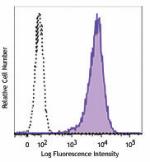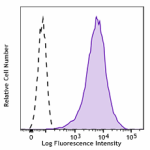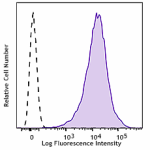- Clone
- 13E11 (See other available formats)
- Regulatory Status
- RUO
- Other Names
- ACKR4, CC-CKR-11, VSHK1, PPR1, CCBP2, CCR11, CKR-11, CCXCKR
- Isotype
- Mouse IgG2b, κ

-

Human CCX-CKR-transfected bovine coronary artery endothelial cells were stained with anti-human CCX-CKR (CCRL1) (clone 13E11) Brilliant Violet 421™ (filled histogram) or mouse IgG2b, κ Brilliant Violet 421™ isotype control (open histogram).
| Cat # | Size | Price | Quantity Check Availability | ||
|---|---|---|---|---|---|
| 362109 | 25 tests | $193.00 | |||
| 362110 | 100 tests | $407.00 | |||
Human CCX-CKR, also known as CCRL1, is a 40 kD, G-protein-coupled, seven transmembrane receptor. CCRL1 is a decoy receptor for CCL2, CCL8, CCL13, CCL19, CCL21 and CCL25 that regulates chemotaxis of lymphocytes and cancer cells. Chemokine binding by CCX-CKR causes its internalization, reducing levels of available chemokine, and thus regulating migration of lymphocytes and cancerous cells. CCX-CKR is expressed by stromal cells of skin-draining lymph nodes, thymic epithelial cells, and immature dendritic cells (DCs). A low CCX-CKR expression in tumor cells correlates with a poor survival rate of breast cancer patients.
Product Details
- Verified Reactivity
- Human
- Antibody Type
- Monoclonal
- Host Species
- Mouse
- Immunogen
- Full length CCX-CKR cDNA
- Formulation
- Phosphate-buffered solution, pH 7.2, containing 0.09% sodium azide and BSA (origin USA)
- Preparation
- The antibody was purified by affinity chromatography and conjugated with Brilliant Violet 421™ under optimal conditions.
- Concentration
- Lot-specific (to obtain lot-specific concentration and expiration, please enter the lot number in our Certificate of Analysis online tool.)
- Storage & Handling
- The antibody solution should be stored undiluted between 2°C and 8°C, and protected from prolonged exposure to light. Do not freeze.
- Application
-
FC - Quality tested
- Recommended Usage
-
Each lot of this antibody is quality control tested by immunofluorescent staining with flow cytometric analysis. For flow cytometric staining, the suggested use of this reagent is 5 µL per million cells in 100 µL staining volume or 5 µL per 100 µL of whole blood. It is recommended that the reagent be titrated for optimal performance for each application.
Brilliant Violet 421™ excites at 405 nm and emits at 421 nm. The standard bandpass filter 450/50 nm is recommended for detection. Brilliant Violet 421™ is a trademark of Sirigen Group Ltd.
Learn more about Brilliant Violet™.
This product is subject to proprietary rights of Sirigen Inc. and is made and sold under license from Sirigen Inc. The purchase of this product conveys to the buyer a non-transferable right to use the purchased product for research purposes only. This product may not be resold or incorporated in any manner into another product for resale. Any use for therapeutics or diagnostics is strictly prohibited. This product is covered by U.S. Patent(s), pending patent applications and foreign equivalents. - Excitation Laser
-
Violet Laser (405 nm)
- Application Notes
-
Additional reported applications for the relevant formats include: immunoprecipitation of CCX-CKR from cell lysates1, induction of CCX-CKR internalization1 and immunofluorescence1. 13E11 recognizes an epitope located within the first 14 amino acids of CCX-CKR.
-
Application References
(PubMed link indicates BioLegend citation) -
- Takatsuka, S. et al. 2011. J. Pharmacol. Toxicol. Methods. 63:250. (IF, IP, Agonist)
- RRID
-
AB_3106250 (BioLegend Cat. No. 362109)
AB_3106250 (BioLegend Cat. No. 362110)
Antigen Details
- Structure
- G-protein-coupled seven transmembrane receptor, 40 kD.
- Distribution
-
Stromal cells of skin-draining lymph nodes, thymic epithelial cells, immature DCs.
- Function
- C-C type chemokine scavenger and decoy receptor, reduces chemokine availability by sequestering them inside the cell.
- Interaction
- β-arrestin.
- Ligand/Receptor
- CCL2, CCL8, CCL13, CCL19, CCL21, and CCL25.
- Cell Type
- Dendritic cells, Epithelial cells
- Biology Area
- Immunology
- Molecular Family
- Cytokine/Chemokine Receptors, GPCR
- Antigen References
-
1. Watts AO, et al. 2013. J. Biol. Chem. 288:7169.
2. Comerford I, et al. 2010. Blood. 116:4130.
- Gene ID
- 51554 View all products for this Gene ID
- UniProt
- View information about CCX-CKR on UniProt.org
Other Formats
View All CCX-CKR (CCRL1) Reagents Request Custom Conjugation| Description | Clone | Applications |
|---|---|---|
| Purified anti-human CCX-CKR (CCRL1) | 13E11 | FC,ICC,IP,Agonist |
| PE anti-human CCX-CKR (CCRL1) | 13E11 | FC |
| APC anti-human CCX-CKR (CCRL1) | 13E11 | FC |
| PE/Cyanine7 anti-human CCX-CKR (CCRL1) | 13E11 | FC |
| Brilliant Violet 421™ anti-human CCX-CKR (CCRL1) | 13E11 | FC |
Compare Data Across All Formats
This data display is provided for general comparisons between formats.
Your actual data may vary due to variations in samples, target cells, instruments and their settings, staining conditions, and other factors.
If you need assistance with selecting the best format contact our expert technical support team.
-
Purified anti-human CCX-CKR (CCRL1)

Human CCX-CKR (CCRL1)-transfected bovine coronary artery end... -
PE anti-human CCX-CKR (CCRL1)

Human CCX-CKR (CCRL1)-transfected bovine coronary artery end... -
APC anti-human CCX-CKR (CCRL1)

Human CCX-CKR (CCRL1)-transfected bovine coronary artery end... -
PE/Cyanine7 anti-human CCX-CKR (CCRL1)

Human CCX-CKR (CCRL1)-transfected bovine coronary artery end... -
Brilliant Violet 421™ anti-human CCX-CKR (CCRL1)

Human CCX-CKR-transfected bovine coronary artery endothelial...
